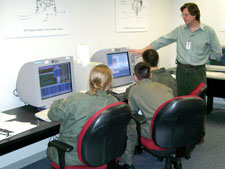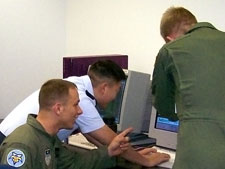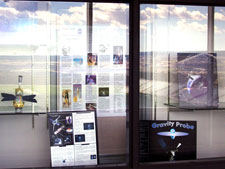GP-B News — Fall 2007
USAFA USE OF THE GP-B SPACECRAFT
With the conclusion of the science data gathering phase of the GP-B mission at the end of September 2005, we began searching for other institutions and/or experiments that might wish to make use of the GP-B spacecraft. With the exception of the depleted superfluid helium needed to maintain the cryogenic environment required to run the GP-P relativity experiment, everything else on the satellite was working fine, and the satellite was expected to remain functional for at least 8 more years. The alternative, for which we began preparing in 2006, was to turn off and hibernate the satellite, essentially making it another piece of “space junk” until it de-orbited some 30 years from now.
Fortunately, former GP-B program manager Gaylord Green, with the help of former astronaut Fred Gregory (who was also a classmate of Green's at the U.S. Air Force Academy), initiated discussions with the Academy (USAFA) on converting GP-B into a platform for training space operations cadets and, with operable GPS receivers, star trackers and several other scientific apparatus, as a source of experiments for several departments at the USAFA.
In the summer of 2006, two cadet teams visited Stanford University to investigate joint SU/USAFA vehicle operations. During that time, Stanford provided detailed training in GP-B operations. Options for vehicle commanding and stand-alone USAFA capability were also investigated. The teams briefed members of the Astronautics and Physics Department, and the Center for Space and Defense Studies upon their return where the decision was made to proceed with the program. Through an OSD grant to the Center for Space and Defense Policy, USAFA continued to pursue GPB for use in Physics experimentation and as an operational asset to train cadets.
Note: We chronicled our joint activities with the USAFA in our monthly GP-B mission updates from June 2006 through February 2007, which you can read in our online archive of GP-B updates.
A Memorandum of Agreement between the USAFA and NASA, which enables the Academy to operate the GP-B spacecraft and use the NASA IONet, was signed in January 2007. Equipment for the first USAFA GP-B Mission Operations Center (MOC) was delivered from Stanford in October 2006. The equipment was successfully integrated into the IONet in February. On 7 May 2007, THE USAFA GP-B MOC successfully sent commands to and received data from the GP-B satellite through a NASA Tracking and Data Relay Satellite System (TDRSS) satellite for the first time. A summer Space 251 program allowed over 250 Academy and ROTC cadets to contact the satellite during status of health passes meeting requirements to wear basic cadet space wings.
Follow on programs for this semester include training cadets in using NASA's scheduling program for satellite passes, learning how to do ephemeris updates, changing the charging profile on the batteries to ensure operation for the next 8 years, and meeting a NASA safety requirement to vent the helium still on board that was used to spin up the gyroscopes. Physics and engineering possibilities include experiments using the star trackers, the GPS receivers on board, and the proton counters. Some of these experiments may tie in with data from the USAFA's own FalconSat-3 studies to provide confirmation of plasma bubble data from this experiment.
Comments or questions regarding the future use of Gravity Probe B can be directed to Steven Waiss, the USAFA Program Manager for GPB.




